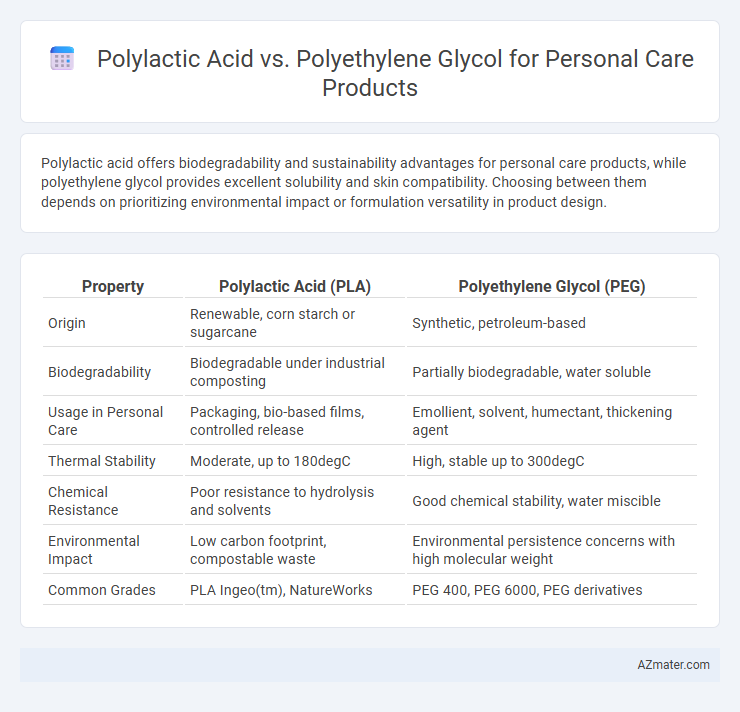Polylactic acid offers biodegradability and sustainability advantages for personal care products, while polyethylene glycol provides excellent solubility and skin compatibility. Choosing between them depends on prioritizing environmental impact or formulation versatility in product design.
Table of Comparison
| Property | Polylactic Acid (PLA) | Polyethylene Glycol (PEG) |
|---|---|---|
| Origin | Renewable, corn starch or sugarcane | Synthetic, petroleum-based |
| Biodegradability | Biodegradable under industrial composting | Partially biodegradable, water soluble |
| Usage in Personal Care | Packaging, bio-based films, controlled release | Emollient, solvent, humectant, thickening agent |
| Thermal Stability | Moderate, up to 180degC | High, stable up to 300degC |
| Chemical Resistance | Poor resistance to hydrolysis and solvents | Good chemical stability, water miscible |
| Environmental Impact | Low carbon footprint, compostable waste | Environmental persistence concerns with high molecular weight |
| Common Grades | PLA Ingeo(tm), NatureWorks | PEG 400, PEG 6000, PEG derivatives |
Overview of Polylactic Acid and Polyethylene Glycol
Polylactic acid (PLA) is a biodegradable, bio-based polymer derived from renewable resources like corn starch, widely used in personal care products for its eco-friendly attributes and biocompatibility. Polyethylene glycol (PEG) is a synthetic polymer known for its water solubility, flexibility, and excellent moisturizing properties, commonly incorporated in lotions, creams, and cleansers. PLA offers sustainability and compostability, whereas PEG provides versatility and enhanced product texture in personal care formulations.
Chemical Structure and Properties Comparison
Polylactic acid (PLA) is a biodegradable aliphatic polyester derived from renewable resources with a linear structure composed of lactic acid monomers, offering high tensile strength and rigidity but limited flexibility. Polyethylene glycol (PEG) is a polyether compound with a flexible, linear chain of repeating ethylene oxide units, characterized by its hydrophilicity, low toxicity, and excellent solubility in water and organic solvents. PLA's chemical structure imparts biodegradability and a higher melting point, while PEG's structure provides superior moisturizing properties and compatibility with various formulations in personal care products.
Biodegradability and Environmental Impact
Polylactic acid (PLA) is a biodegradable polymer derived from renewable resources such as corn starch, offering a lower environmental impact through its ability to break down naturally under industrial composting conditions. Polyethylene glycol (PEG), a petroleum-based polymer, shows limited biodegradability and can accumulate in aquatic environments, raising concerns about long-term ecological effects. The choice of PLA over PEG in personal care products enhances sustainability by reducing plastic pollution and promoting eco-friendly waste management.
Safety and Toxicity in Personal Care Applications
Polylactic acid (PLA) is a biodegradable polymer derived from renewable resources and exhibits low toxicity, making it a safer choice for personal care products with minimal risk of skin irritation or systemic toxicity. Polyethylene glycol (PEG), widely used as a solvent and emulsifier, presents potential safety concerns due to impurities like ethylene oxide and 1,4-dioxane, which can be carcinogenic or irritant contaminants. Regulatory assessments prioritize PLA for eco-friendly personal care formulations, while PEG requires stringent purification and concentration limits to minimize adverse health effects.
Functional Roles in Skincare and Cosmetics
Polylactic acid (PLA) serves as a biodegradable polymer predominantly used in personal care products for exfoliation and texture enhancement, promoting skin renewal through gentle mechanical action. Polyethylene glycol (PEG) functions mainly as a solvent, humectant, and emulsifying agent, improving product stability, moisture retention, and skin absorption of active ingredients in skincare formulations. PLA's natural origin supports sustainable beauty trends, while PEG offers versatile chemical properties ideal for diverse cosmetic textures and delivery systems.
Performance in Moisturizers and Emulsions
Polylactic acid (PLA) offers superior biodegradability and film-forming properties, enhancing the stability and texture of moisturizers and emulsions, while polyethylene glycol (PEG) provides excellent solubility and emulsification capabilities, improving water retention and product spreadability. PLA-based formulations typically yield a lightweight, non-greasy feel and are favored for natural and eco-friendly personal care products. PEG, with diverse molecular weights, allows for tailored viscosity and emulsion stability but may raise concerns regarding skin sensitivity and environmental impact.
Compatibility with Other Formulation Ingredients
Polylactic acid (PLA) demonstrates moderate compatibility with various oils and emulsifiers but may require careful pH adjustment due to its acidic nature, ensuring stability in personal care formulations. Polyethylene glycol (PEG) offers excellent solubility and compatibility with water-soluble ingredients, enhancing emulsification and improving texture in creams and lotions. Both polymers interact differently with surfactants and actives, influencing their suitability based on the target product's ingredient profile and desired performance.
Consumer Perceptions and Market Trends
Polylactic acid (PLA) is increasingly favored in personal care products due to its biodegradability and natural origin, aligning with consumer demand for sustainable and eco-friendly ingredients. Polyethylene glycol (PEG), while effective as a moisturizer and solvent, faces growing scrutiny over potential skin irritation and environmental impact, impacting its market appeal. Market trends indicate a shift towards PLA-based formulations as brands capitalize on green marketing and regulatory pressures promoting reduced synthetic chemical usage.
Regulatory Considerations for Personal Care Products
Polylactic acid (PLA) and Polyethylene glycol (PEG) are subject to distinct regulatory frameworks in personal care products, with PLA often favored for its biodegradability and compliance with stringent environmental regulations. PEG, widely used as an emulsifier and solvent, must comply with strict concentration limits due to potential impurities such as ethylene oxide and 1,4-dioxane, which are regulated by agencies like the FDA and EU's SCCS. Both substances require thorough safety assessments and adherence to regional cosmetic regulations to ensure product safety and consumer protection.
Future Prospects in Sustainable Formulations
Polylactic acid (PLA) offers promising future prospects in sustainable personal care formulations due to its biodegradability, bio-based origin, and compatibility with eco-friendly packaging. Polyethylene glycol (PEG), while widely used for its solubility and moisturizing properties, faces regulatory and environmental challenges related to synthetic origin and potential toxicity. The increasing consumer demand for green products and stricter environmental regulations position PLA as a more favorable choice for sustainable personal care product development.

Infographic: Polylactic acid vs Polyethylene glycol for Personal Care Product
 azmater.com
azmater.com